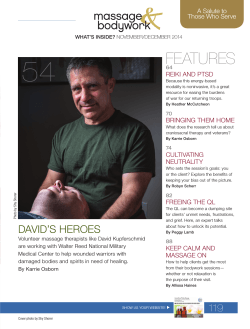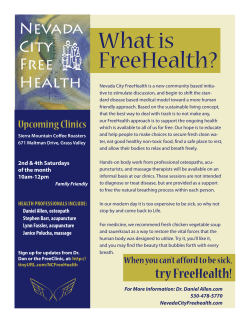
SUMMIT VIEWS November
SUMMIT VIEWS November 2014 SUMMIT VIEWS November 2014 SUMMIT FITNESS 1301 W. UNIVERSITY AVE, FLAGSTAFF, AZ 86001 (928) 774-3476 WWW.THESUMMITFLAGSTAFF.COM A Message from Tony Dear Members The Holiday Months are already upon us. Along with the Holiday’s comes “reasons for not making it in for your fitness routine”. We will not be adding to your reasons. We will be open on Thanksgiving Day, although our hours will be “Holiday Schedule” Thanksgiving Day 7am-12noon (and on Friday the 28th “Black Friday” 7am-7pm). We had several new members join in October due to your referrals. I would like to thank all of you that have referred your family, friends and associates to Summit. Seems too early to talk about Christmas, but once again Summit will be teaming up with the Marines in Toys for Tots. So look for the Toys for Tots box in our lobby around mid-November. Let’s all help make someone’s Christmas special. On behalf of the entire Summit Team thank you for choosing Summit Fitness as your Fitness Facility. Have a Safe Happy Healthy Holiday Season! Tony Giustina, Managing Partner THANKSGIVING HOLIDAY HOURS CLUB HOURS Wednesday Nov 26 5am-8pm KIDZONE Wednesday Nov 26 8:30am-1pm Thanksgiving Day -7am-12noon Thanksgiving – Closed Friday Nov 28 7am-7pm Friday Nov 28 8:30am-1pm Welcome New Members Please join Summit Fitness in welcoming our New Members. The following members have joined between Sept 16th and October 15th Weston Foster, Dennis Brace, Tyler Creamer & Jalyn Schollmeyer, Rick & Yvonne Valdes, Justin Carlen, Jason Christiason, Kylie Sage, Greg Gore, Missy Jeskowski, Brian Beham, Khaled Alotaishan, Deirdre Yazzie, Karen Feess, Miakoda Wolin-Collins, Bradley Barwick, Joseph Cipoelluvo, Kendrick Jones, Veronica Craig, Jack & Michelle Murphy, Nicholas & Jessica Chlupsa, Amber Belt, Jenise Warrick, Robert Bohlin & Jessica Shrewsbury, Abdulhahmau Alsubiei, Turki Alhemidi, Enka Harvey, Jeff Chambers & Kaylee Anderson, Kfir Orgud, Donna Raybould, Chris Murphy & Brit Chamberlain, Turki Alhemidi, Eric Tunney, Michael Rickerd, Colten Hutchinson, Clayton & Teri Pullen and Raymi Todd. SUMMIT VIEWS November 2014 Tips for Strengthening Your Bones Steve Halgrimson M.S. Did you know that over 10 million adults in the United States have osteoporosis, while more than 18 million are at risk for developing this disorder? There’s the perception that osteoporosis is a woman’s issue, however there are over 2 million men affected by this disease. While most of us pay little attention to daily intake of the nutrients associated with optimal bone health, it may be worth your time to periodically assess your dietary intake and supplementation levels of a few important nutrients. Our bones provide us with much more than structural support, though this function can be under-appreciated. Bones are truly amazing! Besides holding us upright, they protect our organs, they co-partner with muscle, enabling us to move, and they synthesize red blood cells that are necessary to carry oxygen to body tissues. Bones are also the major mineral pantry of the body. There is a continual exchange between the bones and the bloodstream so that our bodies maintain mineral levels at optimal thresholds. Many factors contribute to maintaining strong bones. Adequate vitamin D levels and sufficient dietary calcium intake and absorption are among the most important. Other co-factors such as vitamin K2 and magnesium play major roles in bone health and calcium uptake, along with micro-nutrient intake of lesser-known substances such as boron, strontium, and, yes, even minute levels of fluoride. Proper physical activity levels, including weight bearing exercise, also greatly influences bone health. In this article, the first of a two-part series, I will focus on how you can assess your dietary intake of calcium and maximize its absorption. In the second part, I will cover other nutrients important in the bone mineralization process. Most of us are creatures of habit and consume between 15 -20 different types of foods regularly. Assessing your favorite foods for calcium (and other bone supporting nutrients) along with the quantity of each that you consume daily makes it easy to evaluate your intake of calcium. Here’s how you make the calculation! The first step is to identify your favorite foods—or the foods you typically eat—and write them down on a chart. Next, assess and record how much of the food you typically consume in one sitting, i.e., one cup, 8 fluid ounces, etc. Then, using the Nutritional Facts label on the back or side of the product container (if the food is in a package), you can note the calcium delivered per serving. There is a box at the bottom of the label that has separate nutrients listed followed by a percentage number. Food labels are required by law to contain some specific nutrients such as Vitamin A, Vitamin C, Calcium and Iron. The number following a specific nutrient is a percentage of the RDA (Recommended Daily Allowance) that’s contained in the serving size listed at the top of the label. For example, a milk product with a serving size of 8 fluid ounces shows that you will receive 30% of the RDA for calcium. The RDA for calcium in a typical adult 19-50 years old is 1000mg/daily. So if you calculate the total amount of calcium per serving (1000 x .30 = 300mg), you’ll see that there’s 300mg of calcium per 8oz in the milk. On your food list, write calcium and the mg amount. Then, write down the total amount (serving size) of that food you eat each day, and multiply it by the mg you got from your calculation. This number is your daily total for calcium from this food source. There are also databases on the internet, like nutritiondata.com, that will provide macro- and micro- nutrient values for food and food products at various consumption levels. These programs are a great way to calculate any nutrient you may have questions or concerns about, and a good way to determine how much calcium is in a non-packaged food (for example, a 4oz serving of broccoli). Now that you have determined the level of calcium for a single food, write down and do the calculations for all of your favorite foods. You can add them up for one day or over the course of several days. By dividing the number of days into the total figure you get your daily average for calcium. Easy peasy! If you have any questions about the calculation or recording process, feel free to contact me through Summit Fitness. To improve calcium absorption in the GI tract your vitamin D3 levels should be optimized. A simple vitamin D3 blood test, provided by your doctor, can be used to assess your level and indicate if you need to supplement with D3. Most people require some D3 supplementation. A level of D3 between 40-60 ng/mL is optimal. SUMMIT VIEWS |NOVEMBER 2014 Exercise Myths Myth: Walking a mile burns as many calories as running a mile. If the absolute distance covered is the same—1 mile—the total amount of calories burned should be the same, regardless of intensity, right? In fact, many fitness professionals and clients alike conclude that caloric expenditure will not differ between walking and running over this distance. Not so fast. Researchers (Hall et al., 2004) in the mid-2000s directly measured the energy expenditure of walking a mile (3.2 mph) compared to running a mile (6.3 mph) in a group of 24 healthy participants. The findings? Running had a 40% greater energy cost compared to walking. These findings were comparable whether the exercise was performed on the treadmill or over ground. Myth: You Need a sports drink when exercising to replenish your body's electrolytes/minerals/Etc This is one of those myths that got carried away from its original intent. "Sports drinks are important for improving performance in high-intensity exercise that lasts longer than an hour. Think of a marathon or triathlon. The reason: sports drinks provide water to replace what is lost in sweat and sugar (glucose), the fuel muscles need most in intense exercise," Dr. Parr explains. What about low-intensity exercise though, or people who just hit the treadmill for a half-hour every night after work, or bike around town on the weekends? Not necessary at all: "For lower intensity or shorter duration exercise sports drinks are not needed. In fact, if you are exercising with the goal of losing weight, the calories in the sports drink you consume might offset the calories you burned during exercise!" Myth: Lifting weights will make you look bulky Fact: If you've been avoiding the free weights for fear of becoming the Incredible Hulk, no need to flee anymore. When it comes to increasing muscle size, testosterone is key. Men have 20 to 30 times the more testosterone than women, which is why they can bulk up so noticeably. In fact, "strength training will help you lose weight faster and keep it off in the long run," notes Jeffrey Janot, PhD, an assistant professor of exercise physiology at South Dakota State University in Brookings. If you also do cardio, it'll help you retain muscle as you drop fat, as well as prevent your metabolism from slowing. So don't focus all your efforts on the elliptical machine — doing weight resistant exercise could actually help you reach your ultimate goal. November will be a fun month, with the beginning of the Holiday Season. We will be coloring pictures that are a Thanksgiving Theme. We had some really cool Halloween pictures that we did in October. Also parents as a reminder we are all aware of the colds and flu that goes around this time of year please make sure your child is not contagious if bringing them into Kid Zone. We all want to do our part on the prevention of spreading germs. Thank you! Reminder from Accounting Reminder to all members wishing to freeze or cancel their membership, you must fill out a freeze/cancelation form with the front desk. Just talking about what the options are does not warrant the transaction of your membership. Kid Zone Also to all members make sure your credit or debit card on file for your EFT (electronic fund transfer, for account payment), is always updated to avoid a $20 denial fee. If you change cards for any reason you need to change that card we have on file. This can be done simply by filling out a form with the front desk. This would need to be done PRIOR to the 28th of the month. SUMMIT VIEWS |NOVEMBER 2014 Massage therapy - How can it benefit you? By Bradley and Brandie Tremper, BS, LMT Physical exercise and the daily stresses of life place specific strains on the body and mind. Massage therapy offers a variety of benefits that can be valuable tools in helping you feel better, move better and perform better. Some of the benefits of massage include: Stress Reduction- In our fast paced world, our nervous systems are in a stimulated “fight or flight” state. Massage can shift us into relaxed a “rest and digest” state, where our bodies and minds can rejuvenate and restore. During and after a massage, the heart rate slows down, blood pressure is reduced and the adrenals can regenerate. Quicker recovery time – In order to recover from a workout, proper nutrients must be present for rebuilding muscle tissue. A “flush” massage increases circulation, nutrient delivery, and metabolite removal, resulting in a quicker recovery time and decreased soreness. Increased performance – Regular massage increases both flexibility and range of motion, allowing you to move with less restriction and greater ease. Injury prevention – Massage helps to promote supple and flexible tissues, decreasing susceptibility to injury. Injury rehabilitation – Injuries often result in the accumulation of scar tissue, tension and postural compensations. Massage techniques can help remediate these maladies, helping clients to return to a more balanced pre-injury state. Discussing your specific needs, goals, and obstacles with a qualified massage therapist will allow them to develop a personalized treatment plan to help you take your training and overall health to the next level. For more information or to schedule an appointment, contact us at Hypo2 Sport 928-864-5890. Summit members receive a $5 discount on your massage.
© Copyright 2025


















